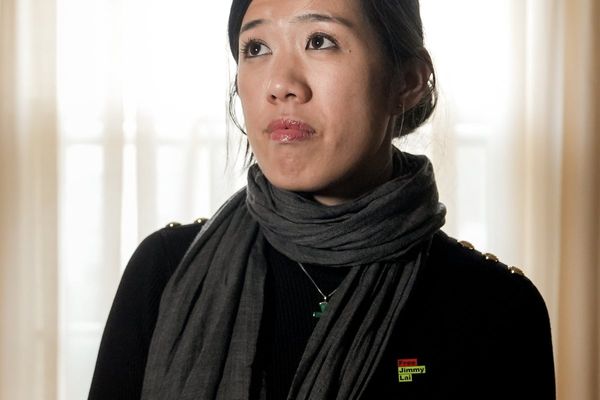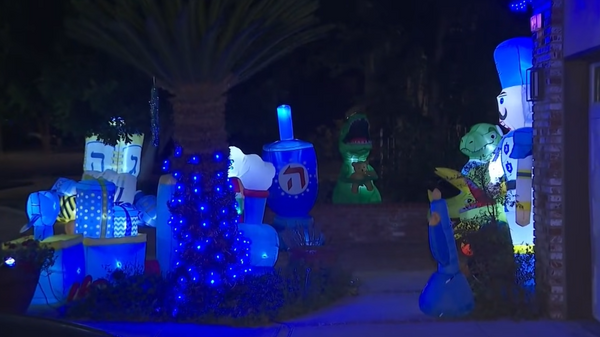
In 2018 Renae Marisma went to see a medieval show at Kryal Castle, a replica fortress and theme park just outside Ballarat in central Victoria. She left with a phone number, a job offer and what would become a very unconventional love story.
“I literally found a knight in shining armour,” she says of meeting her now-husband, Cliff, at a jousting demonstration.
Cliff’s version is more pragmatic: “I think she figured it’s just cheaper to fall in love and marry me than to keep paying me for lessons.”
Five years later Renae was crowned Australia’s jousting champion – her quarter horse Goldie drawing cheers from children who recognised what she calls “the horse that Barbie would ride”.
But two days before she was to defend her title at last weekend’s 2025 championship, Goldie had to be scratched. Mounted on a borrowed horse, Paco, Renae watched Phillip Leitch – her boss at the castle – reclaim the title at the venue where her story began.
The sport Leitch has spent 16 years mastering bears little resemblance to Hollywood spectacle. Real jousting passes last four seconds from start to finish. Riders charge toward each other at full gallop, aiming wooden lances at shields strapped to their opponents’ chests. The lances shatter on impact – the balsa wood tips explode into splinters. Three points are awarded for a complete shatter, two for a clean break, one for solid contact.
“It’s not as dangerous as it looks,” says Leitch, who has watched the sport evolve from rough entertainment to refined competition. “The skill level now is much higher than it was even 10 years ago.”
The mental challenge matches the physical intensity. Jay Dominick, a newer competitor, says the moment when the lance goes into her hand she can experience “almost lose-vision levels of anxiety” before charging down the list.
For others, the sport offers peace. “It’s the serenity I find when I’m actually in my harness and I’m sitting on the horse and I’m looking down that tilt at another spectacular knight ready to play,” Cliff says. “It’s that moment when you just leave and you get this nice, beautiful, perfect pass.”
The partnership between rider and horse is crucial. The ideal jousting horse needs to be “really brave and a little bit dumb”, Renae says – courageous enough to charge towards another while crowds scream and armour clanks, stupid enough to think this reasonable.
When Goldie had to be pulled two days before competition, Renae lost her teammate. “It’s a total partnership,” she says. ‘It doesn’t exist without the horse.”
Leitch’s victory relied on Valiant, his 19-year-old friesian stallion – their bond forged over nearly two decades. “Don’t try and mix things up,” he says. “You know what works. Stick to the plan.”
This year’s 12 competitors represent dramatic demographic change. Six years ago, when Renae started, perhaps three or four women jousted in Australia. This championship split exactly 50:50 – six men and six women.
“That’s something I’ve concentrated on,” says Renae, who found the sport difficult to break into. Among those she now mentors is 21-year-old Sienna Poynton, who marked her major tournament debut after just over a year of training. But there are no handicaps for age, size or gender. Poynton regularly trains with riders who have decades more experience.
The tournament is overseen by a marshal, Mieka Leitch – Phillip’s daughter – who judges competitions, looking for “good horsemanship, good lance control, and getting on target”.
The riders arrived at jousting through different routes. Poynton discovered it through fantasy – she is a lifelong Lord of the Rings fan and was drawn in by movies including A Knight’s Tale. “The idea of just getting to dress up in armour and charge at someone else on a horse with a big stick seemed very fun,” she says.
Renae represents the established equestrians who add medieval combat to their skills. “I definitely came to it from the horse side of things more than the medieval side,” she says.
Leitch took a third route in – being skilled in martial arts and weapons fighting. “I found that jousting was a thing that you could do without being sent to jail for trying to kill someone,” he says.
The sport draws roughly equal numbers from each background, all converging at the same destination: two riders thundering towards each other at combined speeds of 60km/h.
The armour spans centuries and budgets. Poynton’s setup cost less than $1,000 – 21st-birthday money spent on off-the-shelf pieces. Renae’s 15th-century German gothic armour cost about $40,000 – “a really nice car I could have bought”. Cliff has invested even more. “I’m already, you know, 80 grand or something inside my harness,” he says, and that’s not including saddles, bridles and horse gear.
Investment offers protection. “I have absolute faith in my armour that I will not be injured in any way,” Renae says. The confidence shows – while newer jousters might flinch when lances approach, experienced riders in quality armour never do.
The sport’s growing appeal is evident at Kryal Castle. Aaron Albrecht and Brendan Grey flew from Perth for Albrecht’s 40th birthday after a Google search turned up the championship. Both have martial arts backgrounds but had never seen jousting.
“I did not care about jousting until I came here,” Brendan admits. “And now I have a stick with a bunch of signatures on it because we’re fangirling.”
“If you love martial arts, you will love jousting,” he adds. “You just have to understand what’s going on.”
The sport’s future is visible in sisters Lucy and Lana Tyrell, 19 and 17 respectively, who are working as squires and line marshals. They discovered jousting as children visiting Kryal Castle and now train with Renae, and have bought a foal for future competition.
“If you had an angry day, you can take it out on the shield,” Lucy says. They hope to compete next year, already joking about settling sibling arguments through jousting – “Whoever wins the joust wins the argument.”
Leitch’s comments after his triumph capture how far jousting has evolved. “The level of jousting and strategy was just increasing year on year,” he says, still in his 36kg of custom armour. “This is becoming more competitive.”
It came down to just a few points between the top finishers.
As Australian champion, Leitch’s next project is establishing a local jousting association to streamline insurance and make events more accessible. He’s also open to other states hosting future national championships – “part of making that fair for everybody”.
The medieval sport that draws lovers of fantasy, horsemanship and martial arts is building modern infrastructure – transforming from castle entertainment into legitimate competition while keeping its chivalric soul intact.







